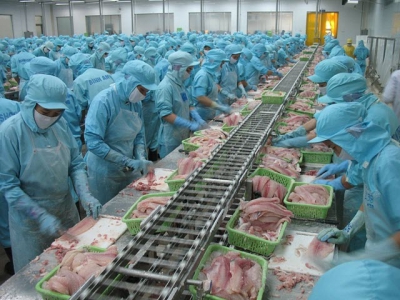Why did the Chinese market leave the top position of importing Vietnamese pangasius?

From the position asthe leading export market of Vietnamese pangasius in 2020, China - Hong Kong has dropped to 4th place (after the US, CPTPP countries and the EU).
Processing pangasius for export
According to the Vietnam Association of Seafood Exporters and Producers (VASEP), as of the first half of February 2021, the total value of pangasius exports to China - Hong Kong reached US$13.55 million (accounting for 8.5 % of total pangasius export value), down 38.6% over the same period last year. In particular, the export value of pangasius to Hong Kong also decreased by 40.5%.
According to the analysis of VASEP, the unexpected decline mentioned above is the consequence of the whole of2020, exporting to this market faces many obstacles due to theCovid-19 pandemic. From the beginning of 2020, the late return of Chinese seafood processing factories, the disruption of trade due to the coronavirus caused the export value of pangasius to China market to suddenly fall.
Since the end of the second quarter and the beginning of the third quarter, activities to this market have become bustling again in preparation for the National Day of China. In October 2020, the export price of frozen pangasius to China - Hong Kong suddenly increased to US$2.52 perkg, which is higher than the same period last year and much higher than during months of the year, ranging from US$1.55 to US$1.65 perkg. This price is lower than the previous quarter but the disease control policy across the border, ports and border gates for all imported food products impactednot only Vietnamese pangasius but also many other imported seafood products of other countries.
Along with that, in the last quarter of 2020, the government of Guangxi, China, which has a border with four provinces of Vietnam, including QuangNinh, Lang Son, Cao Bang and Ha Giang, also made a number of requests to strengthen management of frozen food import activities. Accordingly, imported frozen food products if there are not enough documents including: certificate of testing, quarantine of imported goods, certificate of sterilization, information of legal traceability and testing Nucleic acid negative for COVID-19, goods will not be allowed to be consumed in the market.
Frozen food imported into Guangxi through seaport border gates, when stored, consumed and processed in the area, must be stored in the local centralized monitoring warehouse, taken nucleic acid samples, and completely sterilized for goods traceability management. For products that have performed the above work in other provinces and cities of China, they still have to import warehouses for comparison, then can be consumed or processed.
Vietnamese pangasius exporters mainly export the following pangasius products to China - Hong Kong: Frozen fillet pangasius, frozen pangasius stomach, fried / dried / dried fish bubbles, pangasius whole frozen butterfly cuttings, frozen pangasius belly, cut / cut pangasius fillets and skin, frozen pangasius fillets, frozen seasoned pangasius fillets, whole pangasius fish with frozen organs.
In 2020, there werenearly 145 enterprises and cooperatives exporting pangasius to the Chinese market, 40 enterprises exporting to Hong Kong, of which, three enterprises with the largest export value to the Chinese market during this period are: IDI Corp; VINH HOAN Corp and TG FISHERY. The three largest pangasius exporters to Hong Kong market are IDI Corp, VINH HOAN Corp and VDTG FOOD.
Có thể bạn quan tâm
Phần mềm

Phối trộn thức ăn chăn nuôi

Pha dung dịch thủy canh

Định mức cho tôm ăn

Phối trộn phân bón NPK

Xác định tỷ lệ tôm sống

Chuyển đổi đơn vị phân bón

Xác định công suất sục khí

Chuyển đổi đơn vị tôm

Tính diện tích nhà kính

Tính thể tích ao hồ



 Canned seafood exports rise
Canned seafood exports rise  Long An targets at least 60,000 tonnes of…
Long An targets at least 60,000 tonnes of…